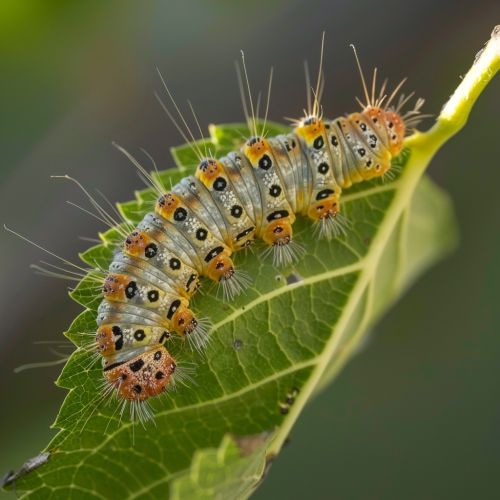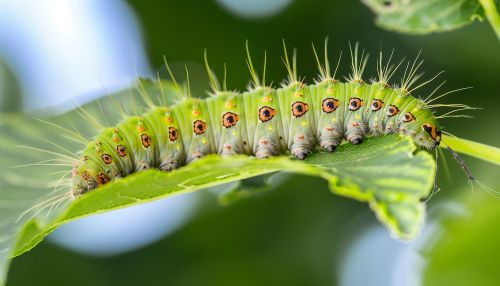Bombyx mori
Introduction
Bombyx mori, commonly known as the domestic silk moth, is an insect from the moth family Bombycidae. It is the primary producer of silk, which has been a significant material in human history for thousands of years. The species is entirely dependent on humans for its reproduction and does not occur naturally in the wild. This article delves into the biology, lifecycle, genetics, and economic importance of Bombyx mori, providing a comprehensive understanding of this fascinating organism.
Taxonomy and Evolution
Bombyx mori belongs to the order Lepidoptera, which encompasses both butterflies and moths. Within this order, it is classified under the family Bombycidae. The genus Bombyx includes several species, but Bombyx mori is the most well-known due to its economic significance.
The evolutionary history of Bombyx mori is closely tied to its domestication. It is believed to have diverged from its wild ancestor, Bombyx mandarina, around 5,000 years ago in China. This domestication process has led to significant genetic changes, making Bombyx mori highly specialized for silk production.
Morphology
Bombyx mori exhibits distinct morphological features at various stages of its lifecycle. The adult moth has a wingspan of 3-5 cm and is characterized by its creamy white color and reduced mouthparts, which render it incapable of feeding. The larvae, or caterpillars, are more notable for their role in silk production. They have a cylindrical body with a series of prolegs and are typically white or yellowish in color.


Lifecycle
The lifecycle of Bombyx mori consists of four main stages: egg, larva, pupa, and adult.
Egg
The eggs are small, oval, and initially yellow, turning dark gray before hatching. Female moths lay between 300 to 500 eggs, which hatch in about 10 days under optimal conditions.
Larva
The larval stage, commonly referred to as the silkworm, is the most critical phase for silk production. The larvae go through five instars, molting four times before reaching full size. During this stage, they feed voraciously on mulberry leaves, which are essential for their growth and silk production.
Pupa
After the final molt, the larva spins a cocoon made of raw silk, which can be up to 1,500 meters long. The pupal stage lasts about two weeks, during which the larva undergoes metamorphosis into an adult moth.
Adult
The adult moth emerges from the cocoon, ready to mate and lay eggs. Adult Bombyx mori moths have a very short lifespan, typically living only a few days. They do not feed and rely solely on the energy reserves accumulated during the larval stage.
Silk Production
Silk production is the most economically significant aspect of Bombyx mori. The process begins with the extraction of silk from the cocoons. The cocoons are first boiled to kill the pupae and soften the sericin, a protein that binds the silk fibers. The silk fibers are then unwound and spun into threads.
The quality of silk produced by Bombyx mori is highly prized due to its strength, luster, and smooth texture. The sericulture industry, which involves the cultivation of silkworms and the production of silk, is a major economic activity in several countries, particularly China, India, and Japan.
Genetics and Breeding
The genetics of Bombyx mori have been extensively studied, making it a model organism in genetic research. Its genome was fully sequenced in 2004, revealing insights into the genes responsible for silk production, immunity, and development.
Selective breeding has been employed to enhance desirable traits in Bombyx mori, such as increased silk yield, disease resistance, and faster growth rates. Genetic engineering techniques are also being explored to produce silk with novel properties, such as increased strength or elasticity.
Economic and Cultural Significance
The domestication of Bombyx mori and the development of sericulture have had profound impacts on human history. Silk was a highly valued commodity in ancient civilizations and played a crucial role in trade along the Silk Road, connecting East and West.
In modern times, silk remains a luxury material used in textiles, fashion, and various industrial applications. The sericulture industry provides livelihoods for millions of people, particularly in rural areas of Asia.
Challenges and Future Prospects
Despite its economic importance, the sericulture industry faces several challenges. These include diseases that affect silkworms, fluctuations in market demand, and competition from synthetic fibers. Research is ongoing to address these issues through improved breeding techniques, disease management, and the development of new silk-based materials.
The future of Bombyx mori and sericulture holds exciting possibilities. Advances in biotechnology and materials science may lead to the production of silk with enhanced properties, expanding its applications in medicine, engineering, and beyond.
